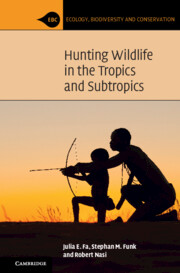Book contents
- Hunting Wildlife in the Tropics and Subtropics
- Ecology, Biodiversity and Conservation
- Hunting Wildlife in the Tropics and Subtropics
- Copyright page
- Contents
- Foreword
- Preface
- Acknowledgements
- Abbreviations
- 1 Eating Wild Animals
- 2 The Backdrop
- 3 How Human Hunters Hunt
- 4 Hunting Optimally
- 5 Estimating Sustainability
- 6 Use and Overuse
- 7 Wild Meat and Zoonotic Diseases
- 8 Closing the Gap
- Book part
- References
- Index
- References
References
Published online by Cambridge University Press: 25 August 2022
- Hunting Wildlife in the Tropics and Subtropics
- Ecology, Biodiversity and Conservation
- Hunting Wildlife in the Tropics and Subtropics
- Copyright page
- Contents
- Foreword
- Preface
- Acknowledgements
- Abbreviations
- 1 Eating Wild Animals
- 2 The Backdrop
- 3 How Human Hunters Hunt
- 4 Hunting Optimally
- 5 Estimating Sustainability
- 6 Use and Overuse
- 7 Wild Meat and Zoonotic Diseases
- 8 Closing the Gap
- Book part
- References
- Index
- References
Summary
- Type
- Chapter
- Information
- Hunting Wildlife in the Tropics and Subtropics , pp. 319 - 402Publisher: Cambridge University PressPrint publication year: 2022
- Creative Commons
- This content is Open Access and distributed under the terms of the Creative Commons Attribution licence CC-BY-NC-ND 4.0 https://creativecommons.org/cclicenses/



